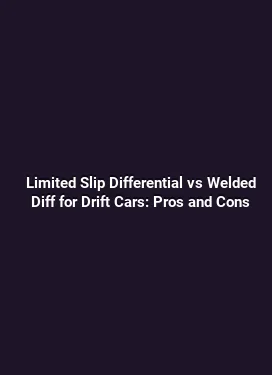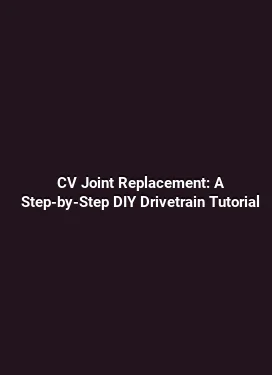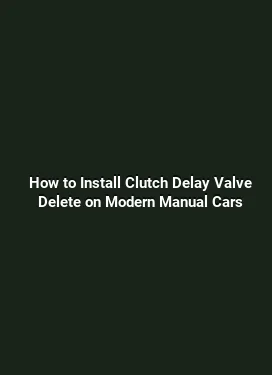Sequential Gearbox Conversion Guide for Track Day Cars Cost Analysis
For track day enthusiasts and race-ready weekend warriors, the choice of transmission is a significant contributor to lap times, drivability, and reliability. A sequential gearbox offers rapid shift times, consistent gear engagement, and a simplified control philosophy that can translate into measurable performance gains. This guide delves into the practicalities of converting a street or race car to a sequential transmission, with a focus on cost analysis, installation considerations, and long-term ownership. Real-world examples, material choices, and maintenance planning are included to help builders, tuners, and track enthusiasts make informed decisions.
Why a Sequential Gearbox for Track Day Applications

A sequential gearbox is designed to simplify shifting by moving through gears in a fixed sequence with up or down shifts via a dedicated lever, paddle, or electronic interface. The tangible benefits for track day cars include faster shift times, improved clutch management, and more precise power delivery during corner exits. Compared to traditional manual transmissions, sequential units reduce the driver workload during demanding sections of a lap, enabling more consistent performances lap after lap.
From a drivetrain perspective, a sequential gearbox interacts with the final drive, differential, and engine torque curve to shape the vehicle’s acceleration profile. Because the system is engineered for quick, repeatable gear changes, teams often report improved throttle control, reduced drivetrain harmonics, and enhanced calibration flexibility. While the upfront cost can be substantial, the long-term advantages in reliability, shift consistency, and potential time savings on track can justify the investment for serious track days and competition-oriented builds.
Core Components of a Sequential Transmission System
Understanding the architecture is essential before evaluating cost. A typical sequential transmission package includes the gearset configured for sequential operation, a shift mechanism (manual lever, paddle, or electronic actuator), a hydraulic or electro-mechanical actuation system, a custom bellhousing, a clutch or torque converter compatible with the gearbox, and an interface to the engine control or standalone transmission ECU. Additionally, the installation must consider drivetrain mounts, alignment, cooling, and integration with the vehicle’s powertrain management system.
Key elements to assess include gear ratios, shaft rigidity, input/output flange compatibility with the differential, and the gearbox’s overall weight. The most common configurations for track-focused builds balance barrier masses with gearing that keeps the engine in its optimal torque band. This often means tighter ratio steps and more evenly spaced gears than a street-oriented manual, enabling shorter shifts that maintain launch control and surge during corner exits.
Gear Ratios, Power Band, and Shift Strategy

Selecting gear ratios is not a one-size-fits-all exercise. Track configurations usually favor closer ratio steps to maximize acceleration in the available power band. A typical sequential setup might feature four to six forward gears with modest delta between adjacent ratios. The goal is to keep the engine within its peak torque or horsepower window across common corner entry and exit speeds, rather than allowing the engine to bog or run into a flat spot during gear changes. This approach reduces wheel spin and promotes predictable behavior under braking and corner exit.
Shift strategy is influenced by the engine’s torque delivery characteristics and the vehicle’s overall weight distribution. For turbocharged or high-revving naturally aspirated motors, modestly taller gears can preserve mid-range torque, while high-revving engines might benefit from tighter spacing to maximize the power peak. Tuning the transmission ECU to optimize upshifts, downshifts, and throttle blip (if supported) is a critical step in realizing the full potential of the conversion.
Cost Elements: Parts, Labor, and Ancillaries
Cost analysis begins with the core hardware, but a holistic view should include ancillary components, compatibility considerations, and long-term ownership expenses. The following sections break down typical cost categories and range expectations based on common track day scenarios and motor vehicle platforms.
Core Transmission Unit: The heart of the conversion, including the gearset, casings, and input/output shafts. Prices vary by brand, billet construction, and whether the unit is new or rebuilt from a factory racing line. For many enthusiasts, a purpose-built, ready-to-install sequential gearbox may range from moderate to premium pricing depending on horsepower rating, shift mechanism type, and integration capabilities with electronic control units.
Clutch System and Torque Handling: Sequential gearboxes require a compatible clutch setup that matches the new powertrain characteristics. This can entail a racing-style multi-disc clutch or a hydraulic pressure plate, along with a load-bearing flywheel. The selection depends on the engine torque, expected peak forces during shifts, and the need for repeatable engagement under track conditions.
Mounts, Bellhousing, and Adapters: A proper physical interface between the engine, gearbox, and chassis is essential. Custom motor mounts, bellhousing adapters, and alignment shims are common, particularly when retrofitting into a non-standard platform. This category also covers alignment checks, royal hardware, and vibration isolation considerations that influence reliability and feel on track.
Cooling and Lubrication: High-load track operation increases heat within the transmission. Upgrading oil cooling, ensuring adequate lubricant flow, and selecting appropriate viscosity grades are part of the design. In some cases, additional oil coolers, scavenge pumps, or relocated cooling lines are necessary to maintain stable temperatures during extended sessions.
Electronic Interface and Calibration: The transmission’s control system often requires an ECU, CAN bus integration, or a dedicated data logger for monitoring. Software calibration of shift points, clutch bite, and brake-throttle coordination is crucial for consistency. The cost can include a standalone transmission ECU, wiring harnesses, and tuning services.
Drivetrain Ancillaries: Differential upgrades, driveshaft modifications, and upgraded mounts may be necessary to handle the altered torque delivery and shift dynamics. The goal is to preserve driveline reliability while maintaining geometry and weight distribution appropriate for track performance.
Installation Labor: Labor costs depend on the vehicle platform, available space in the shop, and whether the setup is a full teardown or a component swap. Labor typically includes drivetrain removal and reinstallation, alignment checks, and comprehensive testing on a dynamometer or track-simulated environment.
Shipping and Handling: For specialty gearboxes, international or cross-region sourcing can incur additional freight, import duties, and handling fees. Budgeting for lead times and contingency parts is prudent given supply chain volatility in high-performance components.
Overall, a baseline sequential conversion can begin in the mid-to-high four-figure range for simpler, lighter-weight packages and non-electrified interfaces, while more advanced systems with integrated electronics, robust cooling, and high torque capacity can approach or exceed five figures. The total investment should be weighed against potential track day benefits, reliability gains, and the intended usage profile of the vehicle.
Installation Considerations and Best Practices
Successful installation hinges on precise mechanical fitment, robust cooling, and coherent integration with vehicle electronics. The following best practices help ensure a smooth conversion and predictable performance under track conditions.
Platform Assessment and Fitment: Begin with a chassis assessment to confirm available space for the gearbox, the geometry of the driveshafts, and compatibility with current suspension components. If necessary, plan for minor chassis modifications or reinforcement to accommodate the new weight distribution and reduced drivetrain flexibility during cornering.
Cooling Strategy: Track sessions generate sustained heat. Incorporate an engineered cooling loop for the transmission, including radiators or heat exchangers, and consider airflow management within the engine bay. A cooler operating temperature extends unit life and reduces the risk of shifting inconsistencies due to thermal throttling.
Lubrication Management: Select lubricant basestock and viscosity aligned with the operating environment and guidance from the gearbox manufacturer. Consider a dedicated oil reservoir if the installation involves high-G cornering and repeated shifts. Periodic oil analysis can help detect wear and contamination early, enabling proactive maintenance.
Control System Integration: The transmission ECU should be harmonized with the engine ECU and traction control systems to prevent conflicts during shifts. This often requires data mapping and calibration sessions with a professional tuner who understands both driveline dynamics and track-specific driving demands.
Weight and Balance: Track day cars benefit from careful weight distribution. Assess how the new transmission affects cabin rhythm, center of gravity, and overall mass. Lightweight bellhousings, optimized flywheels, and carefully chosen driveshafts can preserve handling characteristics while delivering the benefits of a sequential system.
Reliability and Safety: Installing a high-performance sequential gearbox carries safety considerations, including secure mounting, shielded belt routes, and proper emergency release mechanisms for on-track recovery. Thorough testing on a closed course prior to public track days is essential to verify shifting reliability and driver feedback.
Performance Implications: Handling, Power Delivery, and Feel
Beyond the raw cost, the driving experience is a primary determinant of value. A sequential gearbox changes how the car behaves on track, influencing acceleration, braking, and cornering coherence. Reduced throttle modulation and faster shifts translate into sharper lap times, while the driver can focus more on line and braking points rather than clutch control and manual gear selection.
From a handling perspective, the gearbox’s mass and gyroscopic effects must be managed. The right balance between peak torque, powerband width, and gear ratio spread helps maintain predictable torque delivery through corners. This predictability is particularly important on high-downforce cars or those with aggressive aero packages where aero-induced load changes can alter grip levels mid-lap.
Because track days emphasize repeatability, a well-tuned sequential system can offer lower variability in lap times compared to a manual or semi-automatic setup. The driver can rely on consistent shift feel, enabling tighter line control and more aggressive corner exits, which in turn can compensate for minor setup compromises elsewhere on the vehicle.
Maintenance, Longevity, and Ongoing Costs
Maintenance planning is essential for preserving performance and reliability. Regular checks of oil quality, cooling performance, and mechanical clearances help prevent unexpected failures during track sessions. Track day usage typically demands more frequent oil changes, cooling system audits, and thorough inspection of shift forks, gear teeth, and synchronizers where applicable, especially on older or re-purposed platforms.
Consumables such as seals, gaskets, and hydraulic lines can degrade under high heat and long-session stress. A proactive maintenance cadence—including post-session inspections, data log reviews, and pre-event preparation—reduces the likelihood of mid-event surprises. When budgeting for the long term, price in potential component rebuilds or replacements after a defined number of track days or miles, recognizing that high-usage scenarios accelerate wear patterns differently from street use.
Practical Case Studies: Real-World Scenarios
Consider a mid-engine sports car transitioning from a traditional manual transmission to a sequential gearbox. The project begins with an assessment of engine torque capacity, differential compatibility, and the chassis’ ability to handle increased rear drivetrain stiffness. A practical path might involve a mid-pack sequential unit with a hydraulic actuation system, matched clutch pack, and a standalone ECU for shift logic calibration. The expected outcomes include faster mid-corner exits, improved repeatability across multiple track sessions, and reduced driver fatigue during long stints. In parallel, a detailed cost-benefit analysis compares the total ownership cost against projected lap-time reductions and the potential for more consistent race performance.
Another scenario involves a factory-backed touring car prototype converting an existing sequential gearbox. This path emphasizes integration with advanced telemetry, data analytics, and pit-side calibration capabilities. The investment includes not only the gearbox and control hardware but also a dedicated engineering team that can interpret data to optimize shift strategies under different track conditions. The result is a more robust, track-focused system capable of sustained performance across varied circuits and weather scenarios.
Summary of Key Considerations for Decision-Making
When evaluating a sequential gearbox conversion, prioritize clarity on the following: the expected lap-time improvements under your typical track day conditions, compatibility with the vehicle’s chassis and engine, reliability under repeated high-load shifts, and the total cost of ownership including maintenance and potential rebuilds. It is also essential to factor in the learning curve for drivers; even experienced drivers will need seat time to maximize the benefits of a sequential system, particularly in terms of shift timing and throttle modulation on entry and exit corners.
For teams and enthusiasts, the right approach blends thorough upfront planning with practical testing. Start with a modular upgrade path that allows incremental improvements—such as a gearbox with a proven interface, a calibrated ECU, and a compatible clutch package—before committing to a full platform conversion. This staged approach helps manage risk, aligns with race rules or event guidelines, and enables data-driven decisions about further enhancements.
Trend Insights and Semantic Considerations
In contemporary performance engineering, trend-driven materials and data-centric tuning are shaping how sequential gearboxes are perceived and utilized. Track-focused projects leverage telemetry to quantify shift response times, clutch bite precision, and torque transfer during gear engagements. The use of lightweight materials, improved heat dissipation, and modular electronics is becoming more common as manufacturers and hobbyists pursue both performance gains and reliability under demanding conditions. Integrating semantic-structured data around gear ratios, shift times, and torque profiles helps tuners compare configurations across platforms and optimize setups for specific circuits or weather scenarios.
Adopting a holistic perspective—where drivetrain dynamics, vehicle dynamics, and driver inputs are treated as an interconnected system—enables more predictable outcomes. The evolving ecosystem supports better decision-making about which components to upgrade first, how to calibrate shift strategies for different tracks, and how to balance performance gains with maintenance burdens. This approach is especially valuable for track day cars operating in mixed-use environments, where reliability and consistency are as important as outright speed.






